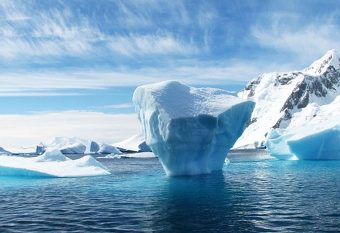
A portion of West Antarctica over twice the size of the US state of California partially melted in 2016 as the result of high temperatures brought by an especially pronounced El Niño, compounded by a rapidly warming climate, according to new research published in the journal Nature Communications.
While it’s been clear for sometime that West Antarctica’s ice sheets are being melted from underneath, by warming oceans, the new work is some of the first to document widespread surface melting occurring as a result of high air temperatures.
The findings were the result of the installation of various measurement instruments a few weeks before the January 2016 warm spell, which were intended to be used to study the effect of cloud cover on the amount of energy that reaches the snow surface.
The press release provides more: “Julien Nicolas, lead author of the paper, is a research associate at the Byrd Polar and Climate Research Center (BPCRC) at The Ohio State University. He’s part of the OSU team that provides weather and climate analysis for AWARE.
“When Nicolas got a January 2016 alert from the AWARE expedition that the weather at their campsite atop of the West Antarctic Ice Sheet had turned unseasonably warm, he checked to see in the satellite data what was happening to the rest of West Antarctica.
“The presence of water in the snow is often hard to detect from visible satellite imagery, especially if clouds block the view. Instead, Nicolas analyzed satellite measurements of the microwave radiation emitted by the snowpack, since dry and wet snows have very different microwave signatures. What he saw during the melting event was an area of roughly 300,000 square miles, including most of the Ross Ice Shelf, that likely contained a mix of snow and water.”
What’s particularly notable about this is that it occurred despite strong westerly winds also being present at the time — which typically keep the warmer air being pushed south by El Niño events out.
BPCRC senior research associate Aaron Wilson noted: “Without the strong westerlies, it’s likely there would have been much more melting.”
Coauthor David Bromwich, professor of geography and leader of the Ohio State team, commented: “In West Antarctica, we have a tug-of-war going on between the influence of El Niños and the westerly winds, and it looks like the El Niños are winning,” he said. “It’s a pattern that is emerging. And because we expect stronger, more frequent El Niños in the future with a warming climate, we can expect more major surface melt events in West Antarctica.”
In other words, it’s another sign of the way that the situation in West Antarctica is changing faster than most official models have suggested it would. It’s fair to guess that the whole West Antarctic ice sheet may well collapse completely within the lifetime of many of those reading this.
Source: cleantechnica.com

